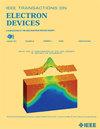高数据速率无线链路行波管ka波段弯曲线慢波结构设计
IF 3.2
2区 工程技术
Q2 ENGINEERING, ELECTRICAL & ELECTRONIC
引用次数: 0
摘要
ka波段(26 - 40ghz)广泛用于卫星链路。特别是,26.5 - 29.5 GHz频段主要用于低地球轨道(LEO)星座的上行链路,也是FR2 (24.25-52.6 GHz)的一部分,用于高容量地面链路。增加26.5 - 29.5 ghz下行频段将增加卫星吞吐量,但目前固态功率放大器(SSPA)模块提供的功率不足,效率太低。ka波段行波管以其高传输功率和高效率被传统地应用于地球静止轨道卫星。紧凑和经济实惠的ka波段行波管将是一个有前途的解决方案,提供传输功率,以实现ka波段的下行链路。曲线(MLs)作为轻量化、小尺寸和低电压运行的慢波结构(SWSs)已经得到了广泛的研究。本文讨论了一种基于ML (ML- twt)的小型廉价ka波段行波管的交互电路。在26.5 - 29.5 ghz的频率范围内,首次提出了两个ML截面与4.56 kv波束电压的椭圆片状波束相互作用的行波管。在线性区域实现了超过31 w的输出功率,增益约为38 db。制作并测量了单段ML-SWS和两段ML-TWT的服务器。新型ML-TWT的紧凑尺寸和低电压使其成为未来ka波段高容量LEO卫星和地面链路中传输功率的有竞争力的解决方案,用于未来5G和6G网络集成。本文章由计算机程序翻译,如有差异,请以英文原文为准。
Ka-Band Meander-Line Slow Wave Structure Design for Traveling Wave Tube for High Data Rate Wireless Links
Ka-band (26–40 GHz) is widely used for satellite links. In particular, the 26.5–29.5-GHz band is mostly used for uplink in low-Earth-orbit (LEO) constellations and is also part of the FR2 (24.25–52.6 GHz) for high-capacity terrestrial links. The addition of the 26.5–29.5-GHz band for downlink would increase the satellite throughput, but presently, solid-state power amplifier (SSPA) modules do not provide enough power and have too low efficiency. Ka-band traveling wave tubes (TWTs) are traditionally used in geostationary Earth orbit (GEO) satellites for their high transmission power and high efficiency. Compact and affordable Ka-band TWTs would be a promising solution to provide transmission power to enable downlink at the Ka-band. Meander lines (MLs) have been extensively investigated as slow wave structures (SWSs) for lightweight, small dimensions, and low voltage operation. In this article, an interaction circuit for compact and affordable Ka-band TWTs based on the ML (ML-TWT) is discussed. The first TWT with two ML sections interacting with an elliptical sheet beam with 4.56-kV beam voltage, in the 26.5–29.5-GHz frequency range, is proposed. More than 31-W output power with about 38-dB gain in the linear region is achieved. A single-section ML-SWS and a sever for the two-section ML-TWT are fabricated and measured. The compact dimensions and low voltage of the novel ML-TWT make it a competitive solution for medium transmission power in the future Ka-band high-capacity LEO satellite and terrestrial links for future 5G and 6G network integration.
求助全文
通过发布文献求助,成功后即可免费获取论文全文。
去求助
来源期刊

IEEE Transactions on Electron Devices
工程技术-工程:电子与电气
CiteScore
5.80
自引率
16.10%
发文量
937
审稿时长
3.8 months
期刊介绍:
IEEE Transactions on Electron Devices publishes original and significant contributions relating to the theory, modeling, design, performance and reliability of electron and ion integrated circuit devices and interconnects, involving insulators, metals, organic materials, micro-plasmas, semiconductors, quantum-effect structures, vacuum devices, and emerging materials with applications in bioelectronics, biomedical electronics, computation, communications, displays, microelectromechanics, imaging, micro-actuators, nanoelectronics, optoelectronics, photovoltaics, power ICs and micro-sensors. Tutorial and review papers on these subjects are also published and occasional special issues appear to present a collection of papers which treat particular areas in more depth and breadth.
 求助内容:
求助内容: 应助结果提醒方式:
应助结果提醒方式:


